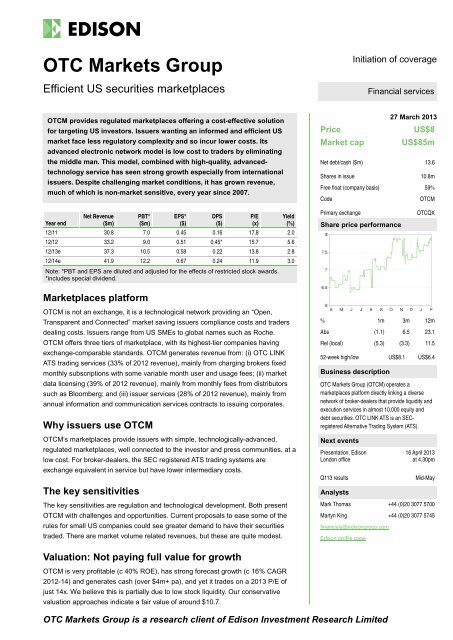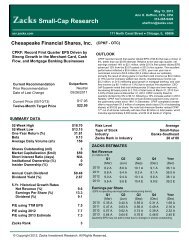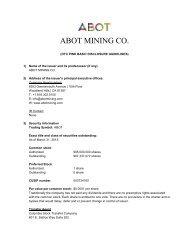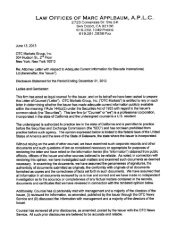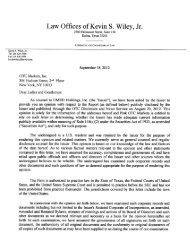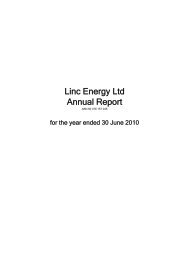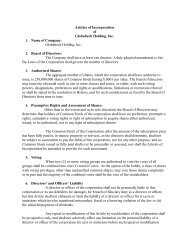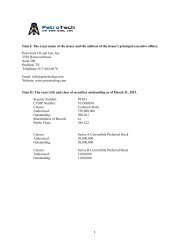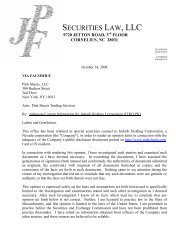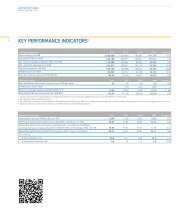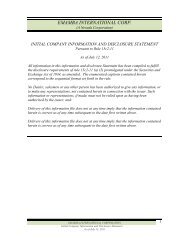OTC Markets Group Inc.
OTC Markets Group Inc.
OTC Markets Group Inc.
You also want an ePaper? Increase the reach of your titles
YUMPU automatically turns print PDFs into web optimized ePapers that Google loves.
<strong>OTC</strong> <strong>Markets</strong> <strong>Group</strong><br />
Efficient US securities marketplaces<br />
Initiation of coverage<br />
Financial services<br />
<strong>OTC</strong>M provides regulated marketplaces offering a cost-effective solution<br />
for targeting US investors. Issuers wanting an informed and efficient US<br />
market face less regulatory complexity and so incur lower costs. Its<br />
advanced electronic network model is low cost to traders by eliminating<br />
the middle man. This model, combined with high-quality, advancedtechnology<br />
service has seen strong growth especially from international<br />
issuers. Despite challenging market conditions, it has grown revenue,<br />
much of which is non-market sensitive, every year since 2007.<br />
27 March 2013<br />
Price<br />
US$8<br />
Market cap US$85m<br />
Net debt/cash ($m) 13.6<br />
Shares in issue 10.8m<br />
Free float (company basis) 59%<br />
Code<br />
<strong>OTC</strong>M<br />
Year end<br />
Net Revenue<br />
($m)<br />
PBT*<br />
($m)<br />
EPS*<br />
($)<br />
12/11 30.8 7.0 0.45 0.16 17.8 2.0<br />
12/12 33.2 9.0 0.51 0.45* 15.7 5.6<br />
12/13e 37.3 10.5 0.58 0.22 13.8 2.8<br />
12/14e 41.9 12.2 0.67 0.24 11.9 3.0<br />
DPS<br />
($)<br />
Note: *PBT and EPS are diluted and adjusted for the effects of restricted stock awards.<br />
*includes special dividend.<br />
P/E<br />
(x)<br />
Yield<br />
(%)<br />
Primary exchange<br />
Share price performance<br />
<strong>OTC</strong>QX<br />
Marketplaces platform<br />
<strong>OTC</strong>M is not an exchange, it is a technological network providing an “Open,<br />
Transparent and Connected” market saving issuers compliance costs and traders<br />
dealing costs. Issuers range from US SMEs to global names such as Roche.<br />
<strong>OTC</strong>M offers three tiers of marketplace, with its highest-tier companies having<br />
exchange-comparable standards. <strong>OTC</strong>M generates revenue from: (i) <strong>OTC</strong> LINK<br />
ATS trading services (33% of 2012 revenue), mainly from charging brokers fixed<br />
monthly subscriptions with some variable month user and usage fees; (ii) market<br />
data licensing (39% of 2012 revenue), mainly from monthly fees from distributors<br />
such as Bloomberg; and (iii) issuer services (28% of 2012 revenue), mainly from<br />
annual information and communication services contracts to issuing corporates.<br />
Why issuers use <strong>OTC</strong>M<br />
<strong>OTC</strong>M’s marketplaces provide issuers with simple, technologically-advanced,<br />
regulated marketplaces, well connected to the investor and press communities, at a<br />
low cost. For broker-dealers, the SEC registered ATS trading systems are<br />
exchange equivalent in service but have lower intermediary costs.<br />
The key sensitivities<br />
The key sensitivities are regulation and technological development. Both present<br />
<strong>OTC</strong>M with challenges and opportunities. Current proposals to ease some of the<br />
rules for small US companies could see greater demand to have their securities<br />
traded. There are market volume related revenues, but these are quite modest.<br />
% 1m 3m 12m<br />
Abs (1.1) 6.5 23.1<br />
Rel (local) (5.3) (3.3) 11.5<br />
52-week high/low US$8.1 US$6.4<br />
Business description<br />
<strong>OTC</strong> <strong>Markets</strong> <strong>Group</strong> (<strong>OTC</strong>M) operates a<br />
marketplaces platform directly linking a diverse<br />
network of broker-dealers that provide liquidity and<br />
execution services in almost 10,000 equity and<br />
debt securities. <strong>OTC</strong> LINK ATS is an SECregistered<br />
Alternative Trading System (ATS).<br />
Next events<br />
Presentation, Edison<br />
London office<br />
Q113 results<br />
Analysts<br />
16 April 2013<br />
at 4.30pm<br />
Mid-May<br />
Mark Thomas +44 (0)20 3077 5700<br />
Martyn King +44 (0)20 3077 5745<br />
financials@edisongroup.com<br />
Edison profile page<br />
Valuation: Not paying full value for growth<br />
<strong>OTC</strong>M is very profitable (c 40% ROE), has strong forecast growth (c 16% CAGR<br />
2012-14) and generates cash (over $4m+ pa), and yet it trades on a 2013 P/E of<br />
just 14x. We believe this is partially due to low stock liquidity. Our conservative<br />
valuation approaches indicate a fair value of around $10.7.<br />
<strong>OTC</strong> <strong>Markets</strong> <strong>Group</strong> is a research client of Edison Investment Research Limited
Investment summary<br />
Company description: “Open, Transparent and Connected”<br />
financial marketplaces<br />
<strong>OTC</strong>M manages a number of marketplaces offering a low-cost and low-regulation option for<br />
companies wanting to have a US market where their securities can trade. There is global demand<br />
for access to US investors and of c 10,000 securities traded on its platforms, <strong>OTC</strong>M has c 1,500<br />
foreign issuers’ American Depository Receipt (ADRs) and 1,500 foreign issuer ordinary shares<br />
accounting for over three-quarters of the dollar value traded. Revenues from TSX-listed Canadian<br />
companies accounted for c 11% of group gross revenue. The best companies, many of which<br />
provide considerable financial information and are compliant with many exchange listing<br />
requirements, use <strong>OTC</strong>QX (43 US companies and 338 foreign companies). This marketplace,<br />
which includes stocks such as Roche, Axa, BASF, and Marks & Spencer, has been a key driver to<br />
revenue in recent periods. <strong>OTC</strong>QB is the “venture stage marketplace” for c 3,300 companies that<br />
are current in their reporting with a US regulator but may not meet all the conditions of <strong>OTC</strong>QX. The<br />
third marketplace is called <strong>OTC</strong> Pink “The Open Marketplace”, and has companies with a range of<br />
financial and other disclosures. Looking forward we see the international growth continuing and<br />
proposals to help smaller companies seeking greater domestic investor appeal and visibility. <strong>OTC</strong>M<br />
has three broad sources of revenue: (i) charging brokers fees to quote, message and trade these<br />
securities, (ii) charging for data and (iii) charging issuers for a range of services. We believe the key<br />
is that most revenue streams are recurring and we note that revenue has increased every year<br />
since 2007.<br />
Valuation: Not paying full value for growth<br />
<strong>OTC</strong>M is trading on a 14x P/E for a business expected to deliver 16% CAGR profit growth over the<br />
next few years. <strong>OTC</strong>M is strongly cash generative and our discounted cash flow approach indicates<br />
a valuation of c $11.5 a share. Our Gordon’s growth model is more conservative (at $9.8). Share<br />
illiquidity is an issue.<br />
Financials: Strong growth expected<br />
Despite the financial crisis, <strong>OTC</strong>M has grown revenue every year since 2007, a trend we expect to<br />
continue. Its cost income ratio has been improving since 2010, which is another trend we expect to<br />
continue. We expect trading to be less important and both data related and issuer services to grow.<br />
The latter assumes continued growth in the international <strong>OTC</strong>QX customer numbers.<br />
Sensitivities: Regulation, markets, technology<br />
• Regulation on other markets: How exchanges are regulated is important, and ironically easing<br />
rules elsewhere would be unhelpful to <strong>OTC</strong>M.<br />
• Regulation of <strong>OTC</strong>M is also important: There is a regulatory proposal (FINRA QCF), which if<br />
implemented would materially reduce the income <strong>OTC</strong>M earns from its data.<br />
• Market confidence: Much of <strong>OTC</strong>M’s income is recurring, but there is an element that is<br />
sensitive to the amount of trading investors have the appetite to do.<br />
• Technology: <strong>OTC</strong> Link ATS is the platform on which trades are conducted and its technology is<br />
critically important.<br />
<strong>OTC</strong> <strong>Markets</strong> <strong>Group</strong> | 27 March 2013 2
Company description: “Open, Transparent and<br />
Connected” financial marketplaces<br />
<strong>OTC</strong> <strong>Markets</strong> <strong>Group</strong> <strong>Inc</strong> (<strong>OTC</strong>M) operates “Open, Transparent and Connected” financial<br />
marketplaces for investors to trade almost 10,000 equity and debt securities linking a diverse<br />
network of over 130 broker-dealers that provide liquidity and execution services. Strong growth has<br />
been seen in recent years in the number of <strong>OTC</strong>QX securities, the highest income earning group,<br />
especially from international companies (with a significant representation of TSX Canadian<br />
companies). In 2012 more than $165bn (2011: $229bn) of dollar volume was traded in <strong>OTC</strong>M<br />
securities. <strong>OTC</strong>M accounted for $36bn 22% market share (2011: $45bn) trading 393bn individual<br />
shares. The securities in the <strong>OTC</strong> marketplaces include c 1,500 ADRs (2011: 1,200), c 1,500<br />
foreign ordinaries (2011: 1,300). There are issues from nearly 700 community banks and nearly<br />
2,700 companies that are current in their SEC reporting, as well as a wide spectrum of securities<br />
not found on exchanges. In 2012, over 95% of the dollar volume of securities traded on <strong>OTC</strong> Link<br />
ATS had current information available to investors. Data is disseminated to subscribers through 54<br />
distributors (2011: 47) including the likes of Bloomberg, Interactive Data Corporation and Fidessa.<br />
Exhibit 1: Breakdown of securities by <strong>OTC</strong>M-tiered marketplaces<br />
No of securities Dec<br />
2009<br />
No of securities Dec<br />
2010<br />
No of securities Dec<br />
2011<br />
No of securities Dec<br />
2012<br />
No of securities 14 Mar<br />
2013<br />
<strong>OTC</strong>QX US 17 21 29 44 43<br />
<strong>OTC</strong>QX Int 61 138 285 356 338<br />
<strong>OTC</strong>QX total 78 159 314 400 371<br />
<strong>OTC</strong>QB ** 3,321 3,851 3,625 3,401 3,388<br />
<strong>OTC</strong> Pink (total) 5,879 5,954 6,227 6,173 6,228 *<br />
Total 9,278 9,964 10,166 9,974 9,987<br />
Source: <strong>OTC</strong>M Edison Investment Research. Note:*Of the <strong>OTC</strong> Pink current number, 2,673 were current Info, 472 Limited info and<br />
3,083 No info basis. The drop in <strong>OTC</strong>QB is due to a market trend for companies de-registration. **Actual launch April 2010.<br />
The strongest growth in recent years has been in the number of companies trading on <strong>OTC</strong>QX, the<br />
highest income earning group, especially from international companies. A seasonal drop is usual for<br />
Q1 given renewals take effect in January. This year the renewal rate was 87% (2011: 95%) with<br />
increased attrition especially in Canadian resource companies. We believe this is driven by larger<br />
companies trying to moderate higher regulator and compliance requirements post the financial<br />
scandal and consider this is likely to continue. <strong>OTC</strong>M has also taken the vast majority of the<br />
business from its main rival (<strong>OTC</strong> BB). We see opportunities for growth in proposals to reduce the<br />
regulation on smaller companies. There are many advantages in smaller companies having<br />
securities traded (including staff motivation, credibility with customers, company valuation etc), but<br />
currently compliance costs are high. Under the Jumpstart Our Business Startups Act, these could<br />
reduce and <strong>OTC</strong>M is a natural place for such companies wanting the low-cost option to have their<br />
securities traded.<br />
Why use <strong>OTC</strong>M<br />
The business model has several competitive cost advantages over exchanges.<br />
• Issuers face lower compliance costs and complexity. Securities are traded, but <strong>OTC</strong>M is not an<br />
exchange. While heavily regulated (see below), this means corporates can establish a market<br />
for their securities without the burdensome costs and regulation associated with a listing. This<br />
is appealing not only to smaller companies where the costs of listing may be disproportionate,<br />
but also to global businesses who want access to the US market.<br />
• Issuers also have access to <strong>OTC</strong>M’s broad network with immediate full distribution to the US<br />
investor community and financial and market press. This visibility can be used to broaden a<br />
company’s appeal.<br />
<strong>OTC</strong> <strong>Markets</strong> <strong>Group</strong> | 27 March 2013 3
• Traders face lower execution costs. Exchanges introduce intermediary costs while <strong>OTC</strong>M puts<br />
traders directly in contact with each other. The cost savings of not having an intermediary can<br />
then be shared. <strong>OTC</strong>M’s network approach should also reduce search costs in that all the<br />
interested parties are on the same multi-sided platform and so they do not need to incur any<br />
costs in looking elsewhere. In a way it is like shopping on eBay rather than trailing round a<br />
number of shops.<br />
• <strong>OTC</strong>M believes its network gives broker-dealers better control over the execution of its client’s<br />
orders improving service levels, best execution and managing capital requirements.<br />
• The connectivity established across the network has established critical mass in both securities<br />
and also broker-dealers, making it the primary place to deal in its securities (see completion<br />
section below). This is an important barrier to entry.<br />
<strong>OTC</strong>QX: “The Best Marketplace with Qualified Companies”<br />
<strong>OTC</strong>M has identified for investors those companies with good disclosure and that meet certain<br />
additional criteria. Given these conditions, these companies represent the lower-risk investments<br />
and often are companies that could be listed on a major US exchange but choose not to. <strong>OTC</strong>M<br />
believes less than 20% of its non-<strong>OTC</strong>QX customers would be eligible for <strong>OTC</strong>QX. As noted above,<br />
the key advantages of <strong>OTC</strong>M are lower costs and regulation, while the disadvantages are the<br />
inability to raise new capital, and the impact on credibility of not meeting listing requirements. With<br />
<strong>OTC</strong>QX representing less than 5% of securities traded there is considerable scope to up-sell this<br />
marketplace to existing clients and encourage them to take more services en route. Also, the<br />
network of advisers to issuing companies still has some years to mature, and we expect a further<br />
increase in securities on the marketplace as their distribution evolves.<br />
<strong>OTC</strong>QX U.S./<strong>OTC</strong>X U.S. premier<br />
Many US companies qualify for trading on <strong>OTC</strong>QX as the final step toward a NASDAQ or NYSE<br />
listing. Other US companies enjoy the efficient compliance-driven and cost-effective model it offers<br />
their investors outside of a traditional exchange listing. The key requirements for <strong>OTC</strong>QX U.S. are:<br />
(i) Ongoing operations (no shells, blank check or insubstantial special purpose acquisition<br />
companies); (ii) A minimum bid price of $0.10 (for preceding 90 business days); (iii) The company<br />
may not be subject to any bankruptcy or reorganisation proceedings; (iv) The company must be<br />
validly existing under the laws of each jurisdiction in which it is organised; (v) At least 50 beneficial<br />
shareholders, each owning at least 100 shares of common stock; (vi) Ongoing quarterly and<br />
audited annual financial reports posted on <strong>OTC</strong>QX.com or EDGAR; (vii) <strong>Inc</strong>lusion in the Standard &<br />
Poor’s Corporation Records or Mergent Manuals (Moody’s Manuals); (viii) A Designated Advisor for<br />
Disclosure (DAD) Letter of Introduction upon application process completion and quarterly and<br />
annually thereafter to <strong>OTC</strong>M confirming that the issuer has made adequate current information<br />
publicly available and meets the <strong>OTC</strong>QX inclusion requirements.<br />
<strong>OTC</strong>QX U.S. is the highest <strong>OTC</strong>M marketplace and adopted by nearly 50 US companies. Of these<br />
about a third are “<strong>OTC</strong>QX U.S. Premier”, which is designed to identify issuers that are of the size<br />
and quality to list on a national stock exchange and has additional requirements of: (i) a minimum<br />
bid price of $1 (for the preceding 90 business days); (ii) at least 100 beneficial shareholders, each<br />
owning at least 100 shares of the company’s common stock; (iii) meeting the financial qualifications<br />
for continued listing on the NASDAQ Capital Market; and (iv) annual shareholders’ meetings.<br />
Many <strong>OTC</strong>QX U.S. customers are emerging-growth companies that may be working to a full<br />
exchange listing but do not yet have the scale to support the full listing requirements. Others are<br />
seasoned companies looking to provide a quality marketplace for its securities. We understand the<br />
churn rate typically ranges between 5-15% pa, with premier customers being the most stable.<br />
<strong>OTC</strong> <strong>Markets</strong> <strong>Group</strong> | 27 March 2013 4
<strong>OTC</strong>QX International and <strong>OTC</strong>QX International Premier<br />
A foreign corporation can opt out of not only the Sarbanes-Oxley Act, but also the voluminous filing<br />
demands of the Securities & Exchange Commission. <strong>OTC</strong>M estimates all told, the savings for a big<br />
firm fleeing a US exchange listing might run to $10m plus a year. There also may be some modest<br />
advantages in having a lower litigation risk relating to certain SEC reporting requirements. As with a<br />
listed ADR, a custodian receives the shares on the foreign market, holds them in custody and<br />
issues a negotiable security equivalent to those shares but which is traded on US markets as a US<br />
security (with all the tax, etc, implications). It trades in dollars and pays dividends in dollars, for<br />
small US investors avoiding the complications of currency conversion.<br />
To qualify for <strong>OTC</strong>QX International a foreign firm must: (i) Have most of its shares trade overseas<br />
and have a security listed on one or more stock exchange in a foreign jurisdiction. (ii) Publish in<br />
English on its website its annual report in the form required by the laws of the country of<br />
incorporation, organisation or domicile. (iii) Have a Level 1 Sponsored ADR programme in the US,<br />
which requires a depositary bank, or a foreign ordinary that is Depository Trust Company (DTC)<br />
eligible F share (such as companies listed on a Canadian exchange). (iv) Have a qualified, thirdparty<br />
Principal American Liaison (PAL) sponsor to help it with the admission process, post<br />
disclosure in English, and be available as a trusted resource regarding all aspects of investor<br />
information needs and US market protocols. (v) Be included in the S&P or Mergent Manual for Blue<br />
Sky compliance, allowing brokers to sell the security in up to 38 states. The first two points were the<br />
result of a 2008 SEC easing of the rules exempting companies from registering their securities with<br />
the SEC and saw a material expansion in the number of ADR programmes. The latter points are<br />
<strong>OTC</strong>M-specific. <strong>OTC</strong>QX Premier has additional NASDAQ-like qualifications that typically are<br />
relevant for the largest companies.<br />
The opportunities for <strong>OTC</strong>QX International are considerable. In BNY Mellon’s market review, the<br />
2012 Depositary Receipt yearbook, BNY Mellon noted the 2012 value traded in the top five listed<br />
programmes (Baidu, Vale, Petrobas, BP, Vodaphone) was over $450bn, while for <strong>OTC</strong>M its top five<br />
(Nestle, Roche, Gazprom, Tesco, BASF) was $19.2bn. The larger ADR programmes are level III<br />
(offering facility) or level II (listing facility) and have the advantages of allowing capital raising and<br />
exchange listing respectively, but if only a few companies currently incurring the costs associated<br />
with these listings were to change to level 1 status, the impact on <strong>OTC</strong>M could be material. In<br />
addition, we believe awareness of the <strong>OTC</strong>M option is still embryonic.<br />
<strong>OTC</strong>QB: “The Venture Stage Marketplace”<br />
<strong>OTC</strong>QB is the venture marketplace for companies that are current in their reporting with a US<br />
regulator. There are no financial or qualitative standards to be in <strong>OTC</strong>QB. <strong>OTC</strong>QB securities may<br />
also be quoted on the FINRA BB. The <strong>OTC</strong>QB allows investors to easily identify reporting<br />
companies traded in the <strong>OTC</strong> market regardless of where they are quoted.<br />
<strong>OTC</strong> Pink: “The Open Marketplace”<br />
<strong>OTC</strong> Pink, the third level of security, is divided into three further levels:<br />
• <strong>OTC</strong> Pink Current: Companies that follow the Alternative Reporting Standard or the<br />
International Reporting Standard by making filings publicly available through the <strong>OTC</strong><br />
Disclosure & News Service. There is a mix of companies on <strong>OTC</strong> Pink Current including, for<br />
example, Nestle. Issuers may chose this marketplace reflecting inter alia their appetite for<br />
engagement with US shareholders and the risk US distribution of information. It also includes<br />
shell or development stage companies with little or no operations as well as companies without<br />
audited financials.<br />
• <strong>OTC</strong> Pink Limited: Designed for companies that make limited information publicly available, for<br />
example those with financial reporting problems, economic distress, or in bankruptcy or that<br />
<strong>OTC</strong> <strong>Markets</strong> <strong>Group</strong> | 27 March 2013 5
simply choose not to provide more. Companies in this category have limited financial<br />
information not older than six months available.<br />
• <strong>OTC</strong> Pink No Information companies: Indicates companies that are not able or willing to<br />
provide disclosure to the public markets, <strong>OTC</strong> Pink No Information includes defunct companies<br />
that have ceased operations as well as ‘dark’ companies with questionable management and<br />
market disclosure practices. Management notes that publicly traded companies that are not<br />
willing to provide information to investors should be treated with suspicion and their securities<br />
should be considered highly risky.<br />
<strong>OTC</strong> Link ATS Trading Services<br />
The <strong>OTC</strong> Link ATS marketplace is provided through the <strong>OTC</strong> Link Alternative Trading System,<br />
which began operation on 1 June 2012. <strong>OTC</strong> Link ATS is operated by <strong>OTC</strong> Link LLC, a FINRA<br />
member broker-dealer, SEC regulated Alternative Trading System and wholly-owned subsidiary of<br />
<strong>OTC</strong>M. <strong>OTC</strong> Link ATS is now responsible for the vast majority of the trading services business line,<br />
including all quoting and messaging services, As a FINRA and SEC regulated entity, <strong>OTC</strong> Link ATS<br />
is required to comply with applicable regulations and undergo periodic examinations by the SEC<br />
and FINRA.<br />
How <strong>OTC</strong>M generates revenue<br />
Revenue has risen every year since 2007 (exhibit 3) and is relatively independent from trading<br />
activity. <strong>OTC</strong>M has developed a range of income lines across trading services (a mix of volume<br />
related and subscriber fees), market data licensing (subscriber based) and issuer services (Exhibit<br />
4 below). The critical business message is that the majority of these revenues are relatively stable<br />
subscription types of business.<br />
<strong>OTC</strong> Link ATS Trading services (33% of 2012 revenue)<br />
<strong>OTC</strong>M charges broker-dealers a number of fees (typically layered by volumes), including (i) quote<br />
fee, charged per stock in which they make a market; (ii) messaging fees, which are charged on a<br />
layered basis, per security per day – the key driver is trading activity; (iii) a dealer application,<br />
charged by the number of authorised dealers and (iv) a view-only quoting service for non-marketmaking<br />
market participants (eg agency only brokers). Trading services generated $11.6m of<br />
revenue in 2012 (2011: $11.7m). The key units here are quote and message income (which has<br />
been increasing) and <strong>OTC</strong>M dealer licence subscriptions, which has seen some pressure as<br />
smaller, manual-trading brokers have been squeezed out of the market (2012 brokers numbers c<br />
130, 2011: c 160). This revenue stream is sensitive to the macroeconomic environment, investors’<br />
confidence and the resultant trading volumes. There is also a small element of rebate to<br />
connectivity fees (c 0.3% of revenue).<br />
Market data licensing (39% of 2012 revenue)<br />
<strong>OTC</strong>M’s real-time market data distribution network includes all the major financial data distributors,<br />
such as Bloomberg (c 13% of group gross revenue), Interactive Data Corporation (5% of total group<br />
gross revenue), and Fidessa. It also encompasses online brokerages including Etrade, Fidelity,<br />
Schwab, Scottrade and TD Ameritrade. They typically pay monthly licence fees, which vary with the<br />
type of licence (different layers offering access to different types of data and different usages such<br />
as internal only or to clients etc). Redistribution fees and rebates are paid to some distributors and,<br />
after a recent favourable negotiation, these account for c 13% of market data licensing gross<br />
revenue (5% group revenue). Around two-thirds of this reporting unit’s revenue comes from<br />
professional licences.<br />
<strong>OTC</strong> <strong>Markets</strong> <strong>Group</strong> | 27 March 2013 6
Issuer services (28% of 2012 revenues)<br />
<strong>OTC</strong>M offers issuers a range of services including: (i) <strong>OTC</strong> Disclosure and News Services such as<br />
the dissemination of financial results. (ii) Compliance services including meeting a range of state<br />
requirements. (iii) Customer Support: Services range from helping understand listing requirements<br />
through to posting news releases to ensure timely informational, educational and regulatory<br />
updates. (iv) This unit also includes the advertising revenue generated from selling display<br />
advertisements on the <strong>OTC</strong>M website. <strong>OTC</strong>QX corporates pay an application fee of $5k and a<br />
recurring annual fee of $15k. With nearly 400 clients, the annual fee alone raises c $6m, over a fifth<br />
of group revenue. Premium services, used by less a tenth of issuers, in 2012 accounted for 11% of<br />
revenue presenting a material opportunity for up-selling.<br />
Exhibit 2: Trend in <strong>Group</strong> Revenue<br />
Exhibit 3: Revenue split<br />
$000s<br />
50000<br />
40000<br />
30000<br />
20000<br />
10000<br />
<strong>OTC</strong>QX<br />
17%<br />
IS premium<br />
services<br />
11%<br />
MD user<br />
licenses<br />
27%<br />
0<br />
-10000<br />
2007 2008 2009 2010 2011 2012 2013e 2014e<br />
Trading Services<br />
Market data licensing<br />
Issuer services<br />
Re-distribution fees and rebates<br />
<strong>OTC</strong> link<br />
subscirption<br />
fees<br />
14%<br />
<strong>OTC</strong> LINK<br />
Usage fees<br />
19%<br />
MD<br />
subscription<br />
licenses<br />
12%<br />
Source: <strong>OTC</strong> <strong>Markets</strong>, Edison Investment Research<br />
Source: <strong>OTC</strong> <strong>Markets</strong>, Edison Investment Research<br />
Management<br />
As may be expected from a management team in financial services technology, the management<br />
team is young with an average age for management of under 40 and for directors under 50. There<br />
is a reasonable balance between experience with the company (average of eight years) and fresh<br />
thought (three of the eight have joined since 2010). R. Cromwell Coulson, president and CEO, in<br />
1997 led a group of investors in acquiring <strong>OTC</strong>M’s predecessor business, the National Quotation<br />
Bureau (NQB) and he still owns 4.2m Class A shares and 130k Class C shares.<br />
The key front-line management are:<br />
• Matthew Fuchs (Managing director, Market data and strategy) joined <strong>OTC</strong>M in 2007 with over<br />
12 years’ experience in the financial technology industry.<br />
• Lisabeth Heese (Managing director, Issuer and information services) joined <strong>OTC</strong>M in 2004 as<br />
the director of issuer and information services. Prior to joining <strong>OTC</strong>M, Liz spent 11 years at<br />
NASDAQ.<br />
• Michael Modeski (President, <strong>OTC</strong> Link LLC) joined <strong>OTC</strong>M in 2011 with over 15 years of<br />
experience in the <strong>OTC</strong> markets at Citigroup, FINRA (as director of <strong>OTC</strong> equities) and Pershing.<br />
• Timothy Ryan (Managing director, Sales and business development) joined <strong>OTC</strong>M in 2005 with<br />
over 15 years of development experience at NASDAQ, The Portal Market, and <strong>OTC</strong>BB.<br />
• Non-executive directors include Neal Wolkoff (former Chairman and Chief Executive Officer of<br />
the American Stock Exchange), Siggi Snorrason (former Head of Trading and Information<br />
Technology at the Iceland Stock Exchange), Louisa Serene Schneider (Columbia Business<br />
School, previously Morgan Stanley and JP Morgan) and Gary Baddeley (former entertainment<br />
group CEO).<br />
<strong>OTC</strong> <strong>Markets</strong> <strong>Group</strong> | 27 March 2013 7
Regulation<br />
The <strong>OTC</strong>M and broker-dealers’ activities in the market are regulated by the Financial Industry<br />
Regulatory Authority (FINRA), the U.S. Securities and Exchange Commission (SEC) and various<br />
state securities regulators. In addition, companies with SEC-registered securities are regulated by<br />
the SEC. <strong>OTC</strong>M does not regulate the <strong>OTC</strong> marketplaces. It is neither a stock exchange nor selfregulatory<br />
organisation (SRO) and is not itself regulated by FINRA or the SEC. The trading system<br />
is operated by <strong>OTC</strong> Link LLC subsidiary as a FINRA broker-dealer and registered with the SEC as<br />
an Alternative Trading System (ATS).<br />
On 8 March 2013 the SEC announced closer regulation of systemically important ATSs which<br />
include <strong>OTC</strong> LINK ATS and as such would be subject to closer regulation. While this will incur some<br />
incremental cost for <strong>OTC</strong>M, it also further enhances the group’s credibility.<br />
FINRA proposed Quotation Consolidation Facility (QCF)<br />
On 13 November 2009, FINRA filed with the SEC a proposed rule change (QCF) whereby FINRA<br />
would provide a national best bid or offer for <strong>OTC</strong> securities and requiring <strong>OTC</strong>M to provide it with<br />
free quotations. These proposals would severely affect market data licensing revenues by<br />
eliminating the subscription income currently earned for distributing such data (nearly half the<br />
reported market data licensing revenues, or about a sixth of group revenue). In addition, there may<br />
be some negative impact on deals routed through <strong>OTC</strong> Link ATS, thus reducing trading services<br />
revenues, harming the value of <strong>OTC</strong>M’s market data. Without management action, group<br />
profitability would be minimal.<br />
There is no timeline for the when QCF may or may not be imposed. Small amendments were<br />
proposed on 18 March 2010, but neither they nor the original proposals have been adopted. We<br />
understand for proposals that have been with the SEC for this length of time, it is quite possible<br />
there will be a further round of seeking comments before anything is finalised. We also note that<br />
since the proposals were suggested <strong>OTC</strong> Link ATS has become a FINRA member broker-dealer,<br />
and a systemically important SEC regulated Alternative Trading System. As it is now regulated,<br />
many of the original reasons for putting the proposals forward should moderate.<br />
<strong>OTC</strong>M has a variety of options if they are adopted, and in public releases has highlighted that it<br />
could bring a legal action against the SEC and/or FINRA. During the legal process it is probable<br />
that an injunction would be given, meaning that the current rules would continue to apply until the<br />
legal process was completed. <strong>OTC</strong>M believes much of the preparation work has been done by its<br />
lawyers during previous lobbying, somewhat moderating its potential costs. We also understand<br />
that <strong>OTC</strong>M would not be liable for FINRA’s costs if it lost. However, any legal action could be<br />
protracted and costly, and could fail.<br />
Other regulatory developments<br />
• Jumpstart Our Business Startups Act/Dodd-Frank Wall Street Reform/Consumer protection act<br />
– some provisions of these developments could prove helpful to <strong>OTC</strong>M by increasing the<br />
number of securities trading on its marketplaces. Many small companies miss out on the<br />
advantages of traded shares because of compliance costs and complexities. If these are<br />
eased, there will be greater demand to have tradable securities and <strong>OTC</strong>M is the low-cost<br />
option.<br />
• At the same time, regulatory burdens are a factor in choosing <strong>OTC</strong>M over listing markets and<br />
the easing of some of these rules for larger companies could see companies continue to list<br />
with exchanges rather than use <strong>OTC</strong>M. <strong>OTC</strong>M has noted that the easing of regulations had not<br />
seen a weakening of demand for its services, suggesting that its low-cost model is still a key<br />
attraction for its (potential) customers.<br />
<strong>OTC</strong> <strong>Markets</strong> <strong>Group</strong> | 27 March 2013 8
• On 14 October 2011, the SEC published FINRA’s proposal to amend Rule 6433 (the “Tier Size<br />
Proposal”), which requires minimum quote sizes by an <strong>OTC</strong>M broker-dealer. The rule reduces<br />
tier sizes, and the number of tiers from nine to six. Management believes that the tier size<br />
reduction would degrade market quality and have a longer-term adverse effect on <strong>OTC</strong> Link<br />
ATS.<br />
Competition<br />
<strong>OTC</strong> Bulletin Board (<strong>OTC</strong>BB)<br />
FINRA-owned <strong>OTC</strong>BB provides access to more than 3,300 securities and has more than 230<br />
participating broker-dealers. We understand technology constraints, some potentially ill-judged<br />
pricing and management distracted for some years by uncertainty over a potential sale mean<br />
<strong>OTC</strong>BB has been losing business to <strong>OTC</strong>M. <strong>OTC</strong>M estimated that the number of quotes on<br />
<strong>OTC</strong>BB in 2006 was c 40k against <strong>OTC</strong>M’s c 25k. The figures at end 2012 were 70k for <strong>OTC</strong>M and<br />
c 1k for <strong>OTC</strong>BB.<br />
BX Venture Market<br />
On 6 May 2011 the SEC approved the creation of the BX Venture Market (BXVM), a proposed<br />
listing market for <strong>OTC</strong> equity securities to be operated by NASDAQ OMX <strong>Group</strong>, <strong>Inc</strong>. Companies<br />
listed on the BXVM must be SEC-registered, be current in their reporting, and meet corporate<br />
governance standards similar to the listing requirements on the NASDAQ Stock Market, although<br />
the quantitative listing standards will be less stringent than those imposed on NASDAQ-listed<br />
companies. BXVM could thus compete for some companies traded on <strong>OTC</strong>QX U.S. and <strong>OTC</strong>QB<br />
marketplaces. In 2011 NASDAQ OMX <strong>Group</strong> announced that the BX Venture Market was expected<br />
to launch during 2012, however no specific plans were disclosed and nothing happened. BXVM’s<br />
website reports the project is on hold (www.bxventure.com/faq/). While not carrying NASDAQ’s<br />
brand, we believe <strong>OTC</strong>M has some key advantages over this venture: (i) it is an established first<br />
mover with market credibility, and (ii) it does not require large-company style corporate governance.<br />
We would expect it to take some time before BXVM has a noticeable impact on <strong>OTC</strong>M, and this will<br />
allow management time to react if the competitive threat proves more than illusory.<br />
Exchanges/ATSs<br />
While not an exchange, <strong>OTC</strong>M is competing for a share of securities trading with exchanges such<br />
as NASDAQ and NYSE, as well as international exchanges and is sensitive to their regulation as<br />
well as its own. Regulation of exchanges and their strategic direction could change the competitive<br />
environment. The more successful that <strong>OTC</strong>M is, the greater the probability that the exchanges will<br />
view its market as more attractive and look to establish me-too marketplaces backed by the<br />
exchange’s infrastructure. This has not happened yet and NASDAQ has yet to go live with a<br />
proposed competitor after announcing its establishment some years ago. At present the other<br />
registered alternative trading systems provide execution services rather than quotation services and<br />
are more customers than competitors of <strong>OTC</strong>M. Private securities markets such as Secondmarket<br />
and SharesPost could evolve as competition. Management notes Secondmarket is trying to<br />
develop a market for community banks.<br />
Technology<br />
While <strong>OTC</strong>M provides a marketplace in securities, it is critically a systems business with in-house<br />
product development ensuring management has direct control. Continued reinvestment in systems<br />
<strong>OTC</strong> <strong>Markets</strong> <strong>Group</strong> | 27 March 2013 9
is a feature of the business model that we expect to continue. <strong>OTC</strong>M is now electronically linked to<br />
traders also interfacing with the major exchanges, and delivery of service consistent with the<br />
technology requirements of this group has been a key feature of <strong>OTC</strong>M, creating an effective<br />
barrier to entry. Continuous re-engineering also reduces the risk that key staff move to potential<br />
competitors. Downtime has been negligible (operational availability 99.998% during 2012) and<br />
largely associated with connectivity with external networks. Legally <strong>OTC</strong>M is not liable to pay any<br />
compensation for downtime, although it obviously would affect the group’s brand and reputation.<br />
Other sensitivities<br />
Stock liquidity<br />
Officers and directors beneficially owned 4.6m shares with the CEO holding 3.4m class A and 130k<br />
Class C directly. In addition his family trust owns 687k shares and a further 11% is held by one<br />
holder (WP Carucci). The shares are concentrated in just 118 holders of record. Trading is limited<br />
(an average of 8,000 shares per week in 2012) creating illiquidity issues and share price volatility as<br />
holders may want to sell a reasonable block of shares or buyers look to execute a large purchase.<br />
The company maintains a share buyback programme with current authorisation to purchase over<br />
250,000 additional shares.<br />
2010 restatement of results<br />
In August 2010 <strong>OTC</strong>M identified that $1.4m of accounts receivable generated in the market data<br />
licensing business from 2003-08 was uncollectable and so wrote it off. The problem arose from<br />
third-party vendor reported sales and historically poor internal controls. These have been<br />
addressed with, inter alia, new accountants, new CFO, new controller and a new collections<br />
system. We note the total accounts receivable (ex Bloomberg) due in the market data licensing<br />
business is under two months of revenue. The charge for bad debts in 2012 was c 50% the level of<br />
2011 and 0.7% total revenue.<br />
Valuation<br />
On our estimates, <strong>OTC</strong>M is trading on a 2013e P/E of 14x for a business expected to deliver profit<br />
growth of c 16% over the next two years. There are no peers on which to value <strong>OTC</strong>M. Our<br />
Gordon’s growth valuation model implies a value of $9.8 based off a sustainable ROE of 20% (c 5%<br />
below 2012 level), a cost of equity of 9% and growth of 5%. Our cash flow approach (taking explicit<br />
forecasts for two years, 10 years on an assumed 5% growth, 9% discount rate and terminal value<br />
at 10x final cash flow, generates a value of $11.5. While not peers, investors may note that<br />
NASDAQ OMX trades on a 2013 P/E of 11.8x, NYSE Euronext on 16.4x, Deutsche Boerse on<br />
12.5x and the LSE on 14.1x.<br />
Financials<br />
Despite the financial crisis, <strong>OTC</strong>M has grown revenue every year since 2007, a trend we expect to<br />
continue. We expect both data-related and issuer services to grow (the latter noting an aboveaverage<br />
attrition rate at the start of 2013 offset by management initiatives to up-sell to existing<br />
clients and continued growth in international corporates) and a recovery in trading services to a<br />
more normal market growth and with less attrition in broker numbers. We are forecasting 12%<br />
revenue growth (compared with 14% over past four years), which is up on 2012 growth, which<br />
suffered a nominal drop in trading revenue. We forecast the steady improvements in cost income<br />
<strong>OTC</strong> <strong>Markets</strong> <strong>Group</strong> | 27 March 2013 10
atio since 2010 will continue, and so have grown costs at 11%, 1% slower than revenue. In 2012<br />
we see a period of IT investment and higher compliance costs, offset by some lower employment<br />
related costs. Should market conditions mean revenue growth is slower than we forecast, we<br />
expect management to pace investment accordingly. These forecasts make the group very capital<br />
and cash generative.<br />
Exhibit 4: Key Financials – profit and loss ($000s)<br />
Year ended December 2009 2010 2011 2012 2013e 2014e<br />
Trading Services 9,894 11,378 11,773 11,640 12,571 13,577<br />
Market data licensing 10,911 11,858 13,111 13,555 14,911 16,402<br />
Issuer services 3,227 4,803 8,067 9,831 11,797 14,157<br />
Gross revenues 24,032 28,039 32,951 35,026 39,279 44,135<br />
Re-distribution fees and rebates (1,944) (2,168) (2,188) (1,842) (2,026) (2,229)<br />
Net revenue 22,088 25,871 30,763 33,184 37,253 41,906<br />
Operating expenses (exc depreciation and<br />
(15,520) (19,723) (22,299) (22,606) (25,000) (27,750)<br />
amortisation)<br />
Depreciation and amortisation (835) (1,017) (1,358) (1,622) (1,800) (2,000)<br />
<strong>Inc</strong>ome from operations 5,733 5,131 7,106 8,956 10,453 12,156<br />
Other income / net interest (89) (69) (115) 30 0 0<br />
<strong>Inc</strong>ome before provision for income taxes 5,644 5,062 6,991 8,986 10,453 12,156<br />
Taxes (2,138) (2,127) (2,139) (3,509) (4,181) (4,863)<br />
Net income 3,506 2,935 4,852 5,477 6,272 7,294<br />
Diluted Adjusted EPS ($) 0.33 0.28 0.45 0.51 0.58 0.67<br />
Source: <strong>OTC</strong> <strong>Markets</strong>, Edison Investment Research<br />
Exhibit 5: Key Financials – Balance Sheet ($000s)<br />
Year end December 2009 2010 2011 2012 2013e 2014e<br />
Current assets<br />
Cash and Cash equivalents 5,385 6,703 10,170 13,611 18,963 24,596<br />
Short term instruments 0 0 1,297 0 0 0<br />
Accounts receivables net of allowances 5,861 5,329 7,194 6,481 7,000 7,750<br />
Pre-paid income taxes 215 582 307 345 450 500<br />
Prepaid expenses and other current assets 652 381 417 744 744 744<br />
Deferred tax assets (net) 102 259 293 203 203 203<br />
Total current assets 12,215 13,254 19,678 21,384 27,360 33,793<br />
Property and equipment (net) 4,021 4,036 5,143 5,066 5,066 5,066<br />
Goodwill 251 251 251 251 251 251<br />
Intangibles 139 88 40 40 40 40<br />
Security deposits 89 181 209 209 209 209<br />
Deferred tax assets (net) 0 0 0 0 0 0<br />
Total Non-Current assets 4,500 4,556 5,643 5,566 5,566 5,566<br />
Total Assets 16,715 17,810 25,321 26,950 32,926 39,359<br />
Current liabilities<br />
Accounts payable 791 387 629 721 600 600<br />
Current portion of bank loan 786 92 0 0 0 0<br />
Accrued expenses and other 2,180 1,970 3,066 2,868 3,000 3,000<br />
Dividend payable 336 414 419 0 500 650<br />
<strong>Inc</strong>ome tax payable 0 0 0 0 0 0<br />
<strong>Inc</strong>ome tax reserve 0 372 109 0 0 0<br />
Deferred revenue 2,731 4,299 6,628 7,670 8,670 9,670<br />
Total Current Liabilities 6,823 7,534 10,851 11,259 12,770 13,920<br />
Bank loan 1,246 0 0 0 0 0<br />
Deferred rent 757 816 926 786 675 575<br />
Deferred tax liabilities net 176 200 475 113 113 113<br />
<strong>Inc</strong>ome tax reserve 0 0 197 277 277 277<br />
Total non current liabilities 2,179 1,016 1,598 1,176 1,065 965<br />
Total Liabilities 9,002 8,550 12,449 12,435 13,835 14,885<br />
Net assets <strong>Inc</strong> non-controlling interests 7,713 9,260 12,872 14,515 19,091 24,474<br />
Year-end no of shares 8,408,942 10,480,945 10,615,433 10,830,885 11,030,885 11,230,885<br />
Equity NAV per share ($) 0.917 0.884 1.213 1.340 1.731 2.179<br />
Source: <strong>OTC</strong> <strong>Markets</strong>, Edison Investment Research<br />
<strong>OTC</strong> <strong>Markets</strong> <strong>Group</strong> | 27 March 2013 11
Contact details<br />
304 Hudson Street<br />
3rd Floor<br />
New York NY 10013<br />
US<br />
Revenue by activity<br />
Issuer services<br />
Market data licensing<br />
28%<br />
39%<br />
+1 (212) 896 4400<br />
www. UotcUmarkets.com<br />
Trading services<br />
33%<br />
CAGR metrics Profitability metrics Balance sheet metrics Sensitivities evaluation<br />
EPS 2010-12 35% ROE 2012 40% Net cash 2012<br />
$13.6m Litigation/regulatory<br />
EPS 2012-2014e 15% Avg ROE 2010-2104e 27% Net cash 2014e<br />
$24.6m Pensions<br />
Revenue 2010-2012 13% Pre-tax margin 2012 27% CA/CL 2012 190%<br />
Currency<br />
Stock overhang<br />
Revenue 2012-2104e 12% Pre-tax margin 2014e 29% CA/CL 2014e 254%<br />
Interest rates<br />
Costs 2010-2012 8% % revenue trad servs 2012 33% Debtor days 2010 75<br />
Equity markets<br />
Costs 2012-2014e 11% Bad debts 2012 0.7% Debtor days 2012 71<br />
•<br />
◦<br />
<br />
•<br />
<br />
<br />
Management team<br />
CEO, president, director: R Cromwell Coulson<br />
In 1997, Cromwell led a group of investors in acquiring <strong>OTC</strong>M’s predecessor<br />
business, the National Quotation Bureau (NQB). Prior to this, Cromwell was an<br />
institutional trader and portfolio manager in distressed and value-oriented<br />
investments.<br />
General counsel: Dan Zinn<br />
Dan joined in November 2010. Prior to joining <strong>OTC</strong>M, he was a partner at The<br />
Nelson Law Firm, LLC, outside counsel to the company. Dan previously worked<br />
in the corporate office of the American International <strong>Group</strong> (AIG).<br />
CFO: Wendy Fraulo<br />
Wendy Fraulo joined as CFO in July 2011 after 12 years of public accounting<br />
experience including M&A transaction services at Deloitte & Touche LLP and<br />
previously audit work on large SEC registrants.<br />
Principal shareholders (%)<br />
R Cromwell Coulson 3.413m direct ownership, (Family trust has an additional 0.687m) 31.9 (6.4)<br />
WP Carucci (1.138m) 10.6<br />
A Wimpfheimer (director 0.385m) 3.6<br />
Other officers and directors beneficial ownership (0.763m) 7.1<br />
R Cromwell Coulson Class C 131k 100%<br />
Companies named in this report<br />
NASDAQ OMX, NYSE Euronext, Deutsche Börse, LSE<br />
EDISON INVESTMENT RESEARCH LIMITED<br />
Edison, the investment intelligence firm, is the future of investor interaction with corporates. Our team of over 100 analysts and investment professionals work with leading companies, fund managers and investment banks<br />
worldwide to support their capital markets activity. We provide services to more than 400 retained corporate and investor clients from our offices in London, New York, Berlin, Sydney and Wellington. Edison is authorised<br />
and regulated by the Financial Services Authority (www.fsa.gov.uk/register/firmBasicDetails.do?sid=181584). Edison Investment Research (NZ) Limited (Edison NZ) is the New Zealand subsidiary of Edison. Edison NZ is<br />
registered on the New Zealand Financial Service Providers Register (FSP number 247505) and is registered to provide wholesale and/or generic financial adviser services only. Edison Investment Research <strong>Inc</strong> (Edison<br />
US) is the US subsidiary of Edison and is not regulated by the Securities and Exchange Commission. Edison Investment Research Limited (Edison Aus) [46085869] is the Australian subsidiary of Edison and is not<br />
regulated by the Australian Securities and Investment Commission. Edison Germany is a branch entity of Edison Investment Research Limited [4794244].<br />
DISCLAIMER<br />
Copyright 2013 Edison Investment Research Limited. All rights reserved. This report has been commissioned by <strong>OTC</strong> <strong>Markets</strong> <strong>Group</strong> and prepared and issued by Edison for publication globally. All information used in the<br />
publication of this report has been compiled from publicly available sources that are believed to be reliable, however we do not guarantee the accuracy or completeness of this report. Opinions contained in this report<br />
represent those of the research department of Edison at the time of publication. The securities described in the Investment Research may not be eligible for sale in all jurisdictions or to certain categories of investors. This<br />
research is issued in Australia by Edison Aus and any access to it, is intended only for "wholesale clients" within the meaning of the Australian Corporations Act. The Investment Research is distributed in the United States<br />
by Edison US to major US institutional investors only. Edison US is not registered as an investment adviser with the Securities and Exchange Commission. Edison US relies upon the "publishers' exclusion" from the<br />
definition of investment adviser under Section 202(a)(11) of the Investment Advisers Act of 1940 and corresponding state securities laws. As such, Edison does not offer or provide personalised advice. We publish<br />
information about companies in which we believe our readers may be interested and this information reflects our sincere opinions. The information that we provide or that is derived from our website is not intended to be,<br />
and should not be construed in any manner whatsoever as, personalised advice. Also, our website and the information provided by us should not be construed by any subscriber or prospective subscriber as Edison's<br />
solicitation to effect, or attempt to effect, any transaction in a security. The research in this document is intended for New Zealand resident professional financial advisers or brokers (for use in their roles as financial<br />
advisers or brokers) and habitual investors who are "wholesale clients" for the purpose of the Financial Advisers Act 2008 (FAA) (as described in sections 5(c) (1)(a), (b) and (c) of the FAA). It is not intended for retail<br />
clients. This is not a solicitation or inducement to buy, sell, subscribe, or underwrite any securities mentioned or in the topic of this document. This document is provided for information purposes only and should not be<br />
construed as an offer or solicitation for investment in any securities mentioned or in the topic of this document. Edison has a restrictive policy relating to personal dealing. Edison <strong>Group</strong> does not conduct any investment<br />
business and, accordingly, does not itself hold any positions in the securities mentioned in this report. However, the respective directors, officers, employees and contractors of Edison may have a position in any or related<br />
securities mentioned in this report. Edison or its affiliates may perform services or solicit business from any of the companies mentioned in this report. The value of securities mentioned in this report can fall as well as rise<br />
and are subject to large and sudden swings. In addition it may be difficult or not possible to buy, sell or obtain accurate information about the value of securities mentioned in this report. Past performance is not necessarily<br />
a guide to future performance. Forward-looking information or statements in this report contain information that is based on assumptions, forecasts of future results, estimates of amounts not yet determinable, and therefore<br />
involve known and unknown risks, uncertainties and other factors which may cause the actual results, performance or achievements of their subject matter to be materially different from current expectations. For the<br />
purpose of the FAA, the content of this report is of a general nature, is intended as a source of general information only and is not intended to constitute a recommendation or opinion in relation to acquiring or disposing<br />
(including refraining from acquiring or disposing) of securities. The distribution of this document is not a "personalised service" and, to the extent that it contains any financial advice, is intended only as a "class service"<br />
provided by Edison within the meaning of the FAA (ie without taking into account the particular financial situation or goals of any person). As such, it should not be relied upon in making an investment decision. To the<br />
maximum extent permitted by law, Edison, its affiliates and contractors, and their respective directors, officers and employees will not be liable for any loss or damage arising as a result of reliance being placed on any of<br />
the information contained in this report and do not guarantee the returns on investments in the products discussed in this publication. FTSE International Limited ("FTSE") (c) FTSE [2013]. "FTSE(r)" is a trade mark of the<br />
London Stock Exchange <strong>Group</strong> companies and is used by FTSE International Limited under license. All rights in the FTSE indices and/or FTSE ratings vest in FTSE and/or its licensors. Neither FTSE nor its licensors<br />
accept any liability for any errors or omissions in the FTSE indices and/or FTSE ratings or underlying data. No further distribution of FTSE Data is permitted without FTSE's express written consent.<br />
Registered in England, number 4794244, Edison Investment Research Limited is authorised and regulated by the United Kingdom Financial Services Authority.<br />
www.edisongroup.com. Registered on the New Zealand Financial Service Providers Register, number 247505, Edison Investment Research (NZ) Limited is registered to provide wholesale and/or generic financial<br />
adviser services and is regulated by the New Zealand Financial <strong>Markets</strong> Authority.<br />
Berlin +49 (0)30 2088 9525<br />
<strong>OTC</strong> Friedrichstrasse <strong>Markets</strong> 95 <strong>Group</strong> | 27 March 280 High Holborn 2013 245 Park Avenue, 39th Floor<br />
Level 33, Australia Square<br />
Level 15, 171 Featherston St 12<br />
10117 Berlin<br />
Germany<br />
London +44 (0)20 3077 5700<br />
London, WC1V 7EE<br />
United Kingdom<br />
New York +1 646 653 7026<br />
10167, New York<br />
US<br />
Sydney +61 (0)2 9258 1162<br />
264 George St, Sydney<br />
NSW 2000, Australia<br />
Wellington +64 (0)4 8948 555<br />
Wellington 6011<br />
New Zealand


